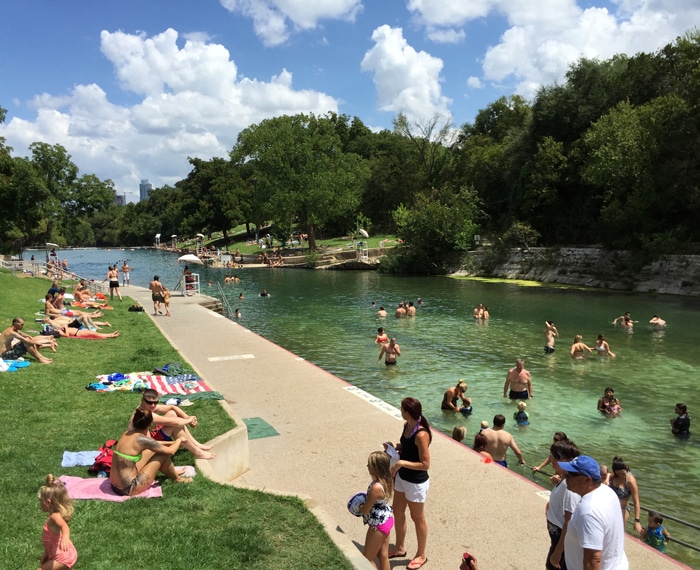
Looking toward the Austin skyline from Barton Springs Pool
Austinites have socialized, fished, waded and swum in the clear blue waters of Barton Springs since the 1800s. The water’s temperature stays at a steady 68-70 degrees while the setting around it changes drastically throughout the year.
I wanted to compile a short guide on what makes Barton Springs Pool quintessentially Austin. In order to scratch the surface of this historical gem, I met with Wayne Simmons, Aquatic Program Manager for the City of Austin, and Clark Hancock, Exhibit Coordinator at the Nature & Science Center.
Historical Glance at Barton Springs Pool
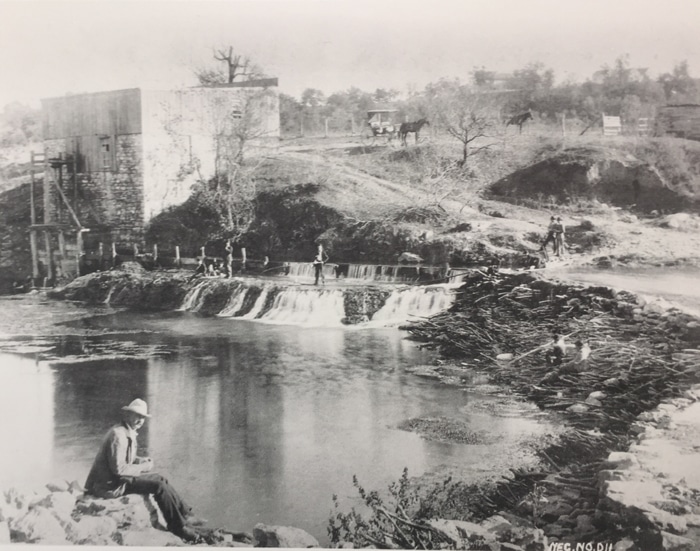
The English & English Mill, 1880
(Credit: Austin History Center and the Splash! Exhibit)
Barton Springs already had a long and interesting history before it was acquired by the City of Austin. American Indian tools and other artifacts have been excavated from the land, and we now know a Comanche trail ran right along the springs. Today, patrons on the south side of the pool may be lounging and doing yoga on what used to be an American Indian midden (refuse heap).
In 1837, Billy Barton moved onto the property with his children and slaves. The region was wild and fairly far away from the main grid of the city. The family lived with roaming cattle, horses and Billy’s two tame bison. Eventually, the area’s name changed from Spring Creek to Barton Creek.
This wasn’t just a place for landowners. In 1871, Michael Paggi encouraged visitors by opening Paggi’s Bathing Houses. He provided bathing suit rentals for women and men and, according to a bulletin in the Daily State Journal, “a set of revolving horses and carriages, which will be accompanied with a fine organ”.
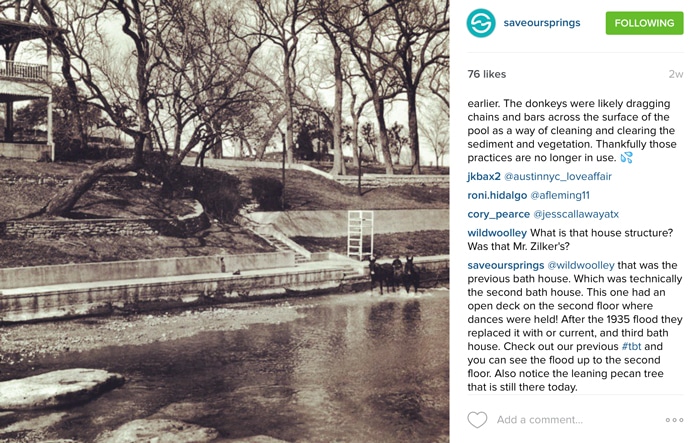
@SaveOurSprings is an excellent Instagram account to follow for past and present pictures of Barton Springs
Barton Springs was also used industrially. In the 1870s, Paggi’s Mill was located in what is now called the Sunken Garden. This area is a few hundred feet downstream on the south side and is characterized by stone retaining walls. The large English & English Flour Mill sat on the south bank of the property from 1880-1886. It used the main spring’s waterflow to produce 50 barrels of flour a day.
Andrew Zilker began buying the land around the springs in 1901. Zilker owned an ice plant, and he raised his horses around the springs to draw wagons carrying chunks of ice to homes throughout Austin. The Zilkers used Barton Springs as site of celebration and welcomed sightseers.
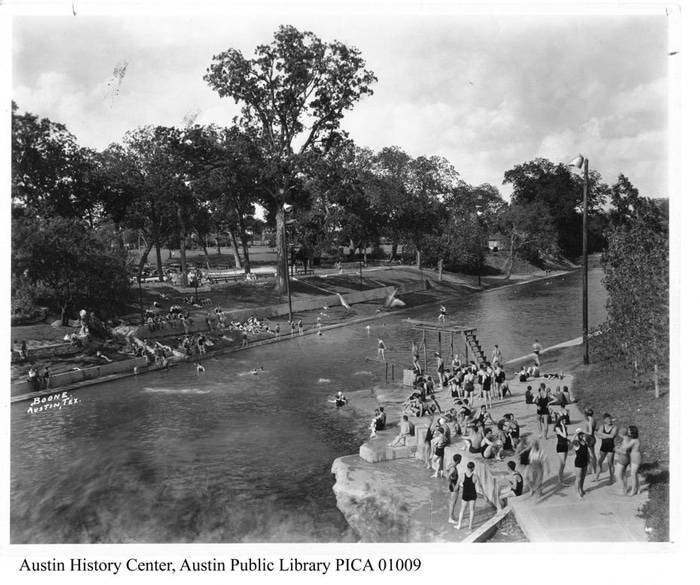
Barton Springs Pool during the 1930s, featuring a high diving board along with a standard one where the current diving board is located (Credit: Austin History Center, Austin Public Library, Austin, Texas)
Becoming Part of the City
After the death of his wife, Ida, Andrew Zilker decided to give his land (which includes present day Zilker Park and Barton Springs Pool) to the Austin School District. He planned for the City of Austin to then buy it from the School District and make the land a public park. After this process, the District would use the funds for vocational and home economic studies. Through a series of deals from 1918 to 1934, the plan worked.
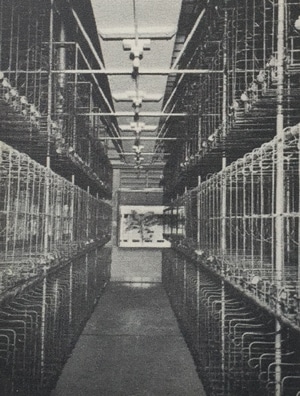
The basket system in the Barton Springs bathhouse (Credit: Architectural Record, December 1948 and Splash! Exhibit)
During this time, the old English & English Mill foundation was torn down and a new two-story bathhouse was built. This wooden building included a dancehall upstairs.
Next, construction began on a permanent dam. (Before this time, people had to stack rocks to create a dam every spring.) The concrete area on the shallow end was also added as a children’s wading area.
In 1935, massive flooding warped the bathhouse and it eventually became unusable. It wasn’t until after the Great Depression and WWII ended that our current stone bathhouse opened, though it functioned a bit differently than it does now. Back then, visitors paid through the entryway, split into men and women’s rooms to change into their bathing suits (since one wouldn’t arrive in their swimwear), and then left their things in a container in a three-level basket system along the changing room walls.
Creation and Cleaning
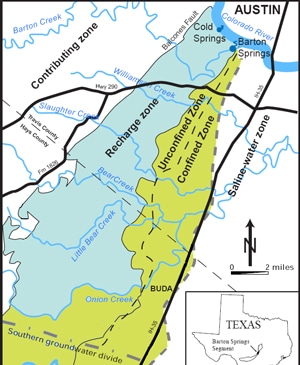
Barton Springs Edwards Recharge Zone and Aquifer Boundaries Map from the SOS Website
Barton Springs Pool is actually made up of four main springs:
- Upper Spring (west of the pool)
- Main Spring (near the diving board)
- Eliza Spring (around the concession stand area)
- Old Mill Spring (at the Sunken Garden)
The water comes from the Barton Springs Recharge Zone, where it travels through porous Edwards limestone underground and out to the springs. If you were to dive 13-16 feet down near the diving board, you could feel the water coming out at about 100 cubic feet per second.
With all of this water moving into the pool and all of the people (and creatures) using the pool, it can get messy. Every Thursday, a crew of staff members and volunteers from Friends of Barton Springs clean the pool inside and out. They use pressure washers and hoses to simulate water flow to rinse sediment downstream, scrapers to remove algae off the concrete walls and brooms to sweep algae off of the limestone so it’s less slippery. Some areas are carefully avoided because they’re home to small, unique amphibians.
Very Special Salamanders
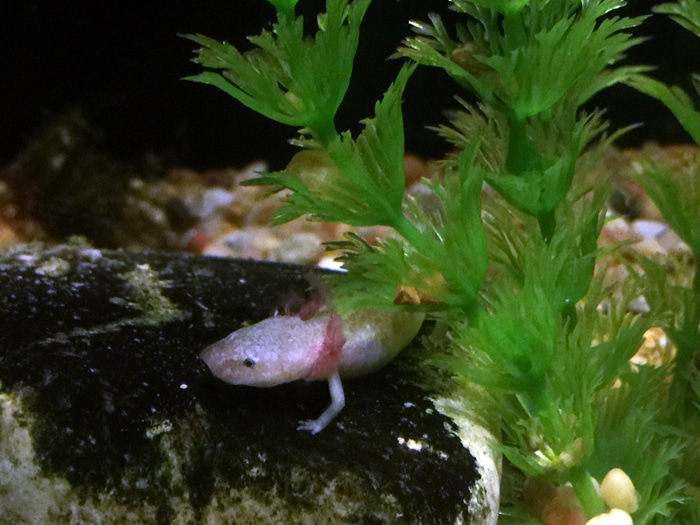
Eurycea sosorum, the Barton Springs salamander
Many people will visit the pool and never see one, yet the Barton Springs salamander and Austin Blind salamander only live in Barton Springs. Much is still to be discovered about these aquatic creatures. Every month, researches dive in scuba gear and turn over every rock to count the salamanders in each spring location.
They are lungless, so they breathe in oxygen from flowing water through their gills and skin. They live among the pebbles and mainly eat microscopic crustaceans, though they’ve been known to supplement their diet with earthworms. During floods, they’re able to hold on to rocks while the water rushes around them.
Our salamanders are living in a fragile environment, and they are endangered. Visitors to the pool should be mindful to leave them and their habitat among the rocks and pebbles alone.
Your Visit
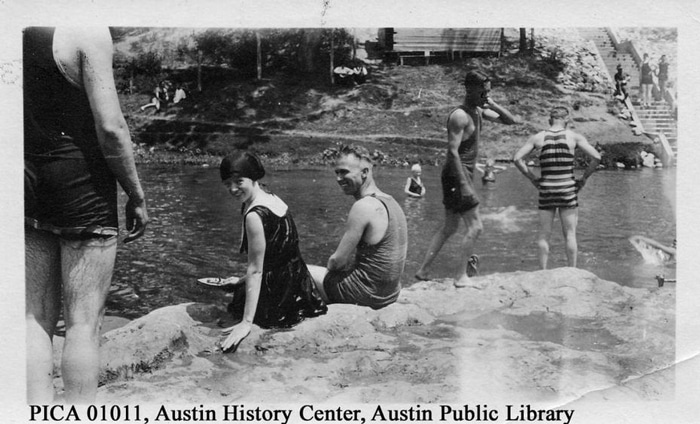
Barton Springs during WWI (Credit: Austin History Center, Austin Public Library, Austin, Texas)
Barton Springs Pool is open from 5 a.m. to 10 p.m. daily. On Thursdays, it is closed from 9 a.m. to 7 p.m. for cleaning. Every day from 5-8 a.m. and 9-10 p.m., there are no lifeguards on duty and the pool is free. In spring 2016, pay-to-park meters were installed, so the entrance booths are now obsolete.
The pool is very popular on the weekend, so be prepared to wait in line and know that parking might not be easy to find. Daily entry fee, punch card and season pass information can be found on the city’s website.
If you’re visiting from 10-5 p.m. on Tuesday through Saturday, or Sunday from 12-5 p.m., be sure to check out the Splash! Exhibit at the main entrance. There you can learn more about Barton Springs’ history, see interactive education tools and find a few of the famous salamanders.
There are no food or coolers allowed in order to prevent fire ants and other pests, but there is a concession stand near the main entrance. Be sure to get your hand stamped before leaving the pool area if you want to return. No hard balls or Frisbees are allowed. Running is prohibited, and children must be supervised at all times. Also, please obey the lifeguards. They are an integral part of what makes the pool a successful community environment.

The deep end of Barton Springs Pool
Have you heard howling in the area? Full moon parties started as grassroots events by people who were regular swimmers at the pool and wanted to casually spend time together. Now these parties have an energetic atmosphere, with people entering the gates at 9 p.m. to howl at the moon until the pool closes at 10 p.m. The howling is even starting to occur on non-full moon nights.
To keep up to date with the pool, check the city’s website and “like” the Austin Parks and Recreation Facebook page. Learn more about our city treasure through Living Springs, an ongoing documentary series about the people of Barton Springs. Also, check out the following nonprofits who champion the springs:
- Friends of Barton Springs Pool
- Save Our Springs Alliance
- Save Barton Creek Association
- Hill Country Conservancy
If you’d like to read more about the history of the springs, see this incredibly informative document.
Our Community

Diving into Barton Springs Pool
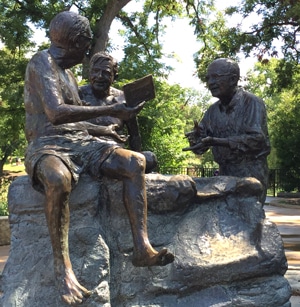
Philosopher’s Rock statue by Glenna Goodacre.
In the 1950s, Naturalist Roy Bedichek and Texas Historian Frank Dobie would “hold court” on Bedi’s rock near the diving board. It was like Austin’s version of a French salon. Historian Walter Webb is shown here in his clothes, since he never swam but was still a part of the lively discussions that took place between educators, bankers and lawyers at the pool.
Whether you jump right into the cool water or shuffle in slowly, you become a part of Barton Spring Pool’s identity, and you join the site where many extraordinary people have stood.
Beverly Sheffield, who ran the Austin Parks and Recreation Department, made a goal at the age of 50 to swim the distance from New York to Los Angeles in Barton Springs Pool. He went well beyond the 2,820 miles. Buster Robinson was the first caretaker of Zilker Park, and he lived with his family in the caretaker’s cottage near where the playground is today. High school senior Joan Means started swim-ins in the 1960s to end racial segregation. The list of fascinating Austinites at Barton Springs Pool could go on and on.
The lifeguards, staff and volunteers keep the pool safe and beautiful. Numerous Austinites have fought for ordinances to protect the springs and keep developers away and people like my guides, Wayne and Clark, spread their contagious knowledge and appreciation. As long as we remember what a treasure we have in Barton Springs Pool, we can look forward to seeing who positively impacts the “soul of Austin” next.
@MadameKLM wants to know:
Would you share your most memorable story about Barton Springs Pool?
- Guide to Bat Season in Austin - July 20, 2020
- Reimagining Life With Rachel Ahern of Weird City Taxidermy - March 28, 2017
- SXSW Red Carpet Musings With Todrick Hall, Nick Offerman - March 22, 2017

Not only is it the Soul of Austin, it’s the Crown Jewel of Texas.
FWIW, Barton Springs was the subject of a 2007 Documentary called “The Unforeseen.” It’s finally on iTunes as of a few weeks ago. ( https://itunes.apple.com/us/movie/the-unforeseen/id1009039900 )
The Soul of Austin is pretty much gone.